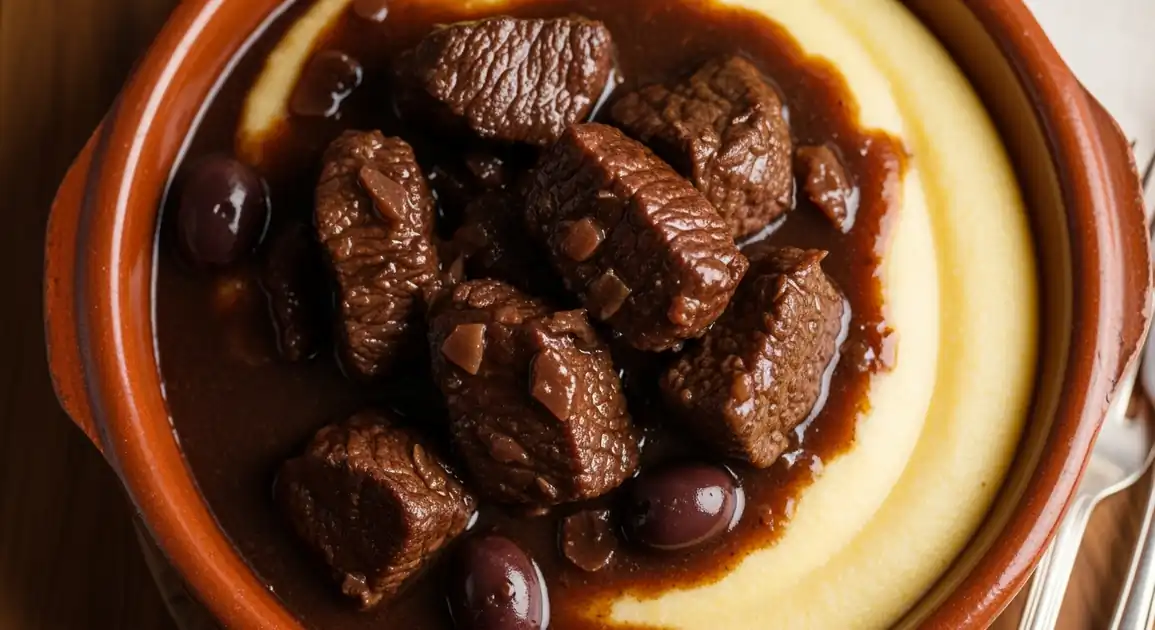Daube Niçoise
Daube Niçoise

Description
Daube Niçoise is a celebrated dish primarily from the city of Nice and the surrounding Alpes-Maritimes department in Provence, Southeastern France. While most authentic in its home region, variations of Provençal daube can be found in traditional restaurants across France, especially those featuring regional cuisines.
Dietary Information
Serving information
Serving style
Served hot as a main course in a deep bowl or plate. Traditionally accompanied by creamy polenta, gnocchi, or fresh tagliatelle pasta in Nice.
Quick facts
Standard French restaurant hours: Lunch approx. 12 PM - 2:30 PM, Dinner approx. 7 PM - 10:30 PM.
Safety Tips
What to Look For
-
Served piping hot
Ensures the dish is freshly heated to safe temperatures, crucial for slow-cooked meat dishes.
-
Reputable restaurant with clean premises
Choose restaurants known for good hygiene and quality food, especially those specializing in local cuisine.
-
Meat is extremely tender
Authentic daube requires long cooking, which ensures tenderness. Tough meat might suggest rushed or improper preparation.
-
Rich, savory aroma
The dish should smell deeply savory and appealing. Any off or sour smells are a red flag.
What to avoid
-
Lukewarm or cool stew
Indicates improper holding or reheating, a significant food safety risk.
-
Restaurants with poor hygiene ratings or visibly dirty conditions
Increases the risk of contamination.
-
Tough or chewy beef
Suggests undercooking or poor quality meat, potentially affecting both taste and safety if not cooked long enough.
-
Watery or thin sauce
While not primarily a safety issue, it indicates poor quality and lack of slow cooking.
Price information
Price range
Budget tips
- Look for it as part of a 'formule' (set menu) at lunchtime for better value.
- Restaurants outside the main tourist centers might offer slightly lower prices.
- It's a substantial dish, often representing a main course price point.
Value indicators
- Quality and tenderness of the beef.
- Richness and depth of flavor in the sauce.
- Presence of authentic Niçoise ingredients (cèpes, olives).
- Generous portion size.
- Indication of 'fait maison' (homemade).
Where to Find This Dish
Provence-Alpes-Côte d'Azur Region
Best experienced in its home region, particularly in Nice and surrounding towns.
Nice Old Town (Vieux Nice), Cours Saleya, Provençal villages
Lunch, Dinner
Restaurants Specializing in Provençal/Niçoise Cuisine
Seek out establishments explicitly focused on these regional foods nationwide.
Various city locations
Dinner
Vendor Tips
- Look for restaurants with the 'Cuisine Nissarde' label in Nice, indicating adherence to traditional recipes.
- Ask about the specific ingredients (cèpes, olives) if seeking the true Niçoise version.
- Pair with a local red wine from Bellet (Nice AOC) or Côtes de Provence.
How to Order
Regional Variations
-
Daube Provençale
(Daube Provençale)
The broader category of Provençal beef stew. May not include the specific Niçoise elements like cèpes or olives, often simpler with carrots, onions, garlic, herbs, and wine.
-
Daube Avignonnaise
(Daube Avignonnaise)
A variation from Avignon, often made with lamb instead of beef and incorporating white wine and olives.
-
Daube with Orange Zest
(Daube à l'Orange)
Some Niçoise and Provençale recipes prominently feature orange zest, adding a distinct citrus note.
-
Daube with Different Meats
(Daube d'autres viandes)
While beef is standard, daubes can also be made with lamb ('Daube d'agneau'), wild boar ('Daube de sanglier'), or even octopus ('Daube de poulpe') in coastal areas.
Cultural context
History
Daube itself is a classic Provençal dish with peasant origins, designed to tenderize tougher cuts of beef through long, slow cooking in a 'daubière' (a specific pot). The 'Niçoise' variation reflects the local terroir of the Nice area, incorporating ingredients readily available like olives and wild mushrooms (cèpes). It became a staple of Niçoise family Sunday lunches and traditional restaurant menus, embodying the region's culinary identity.
Local significance
A flagship dish of Niçoise identity, representing local ingredients and the tradition of slow, convivial cooking.
Eating customs
- Enjoyed as a substantial main course.
- The accompaniment (polenta/gnocchi/pasta) is integral for enjoying the sauce.
- Savoring the deep flavors developed through slow cooking.